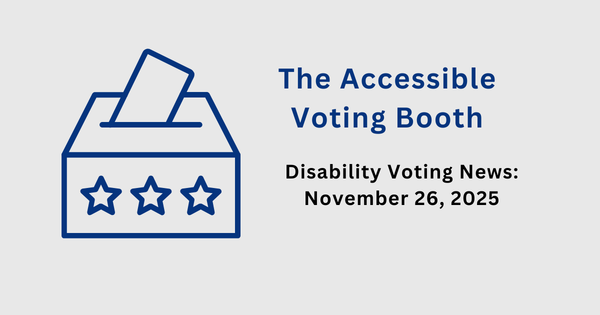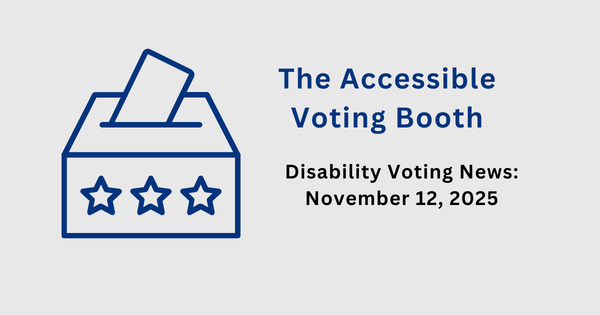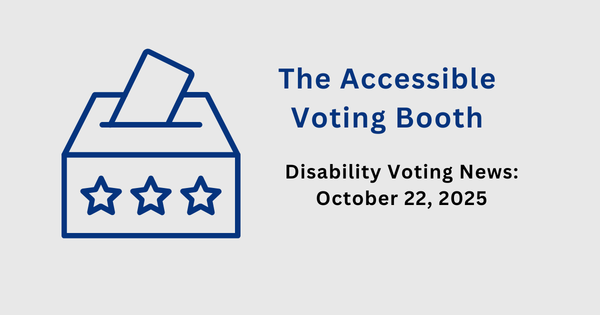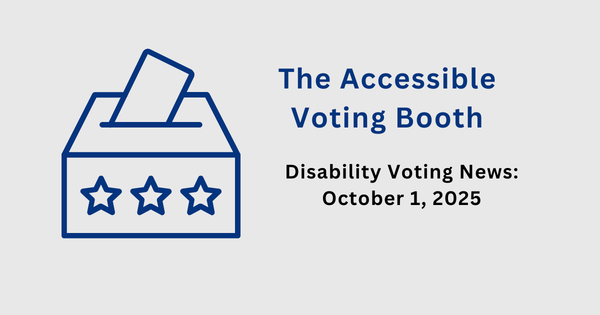Disability Voting News: June 25, 2025
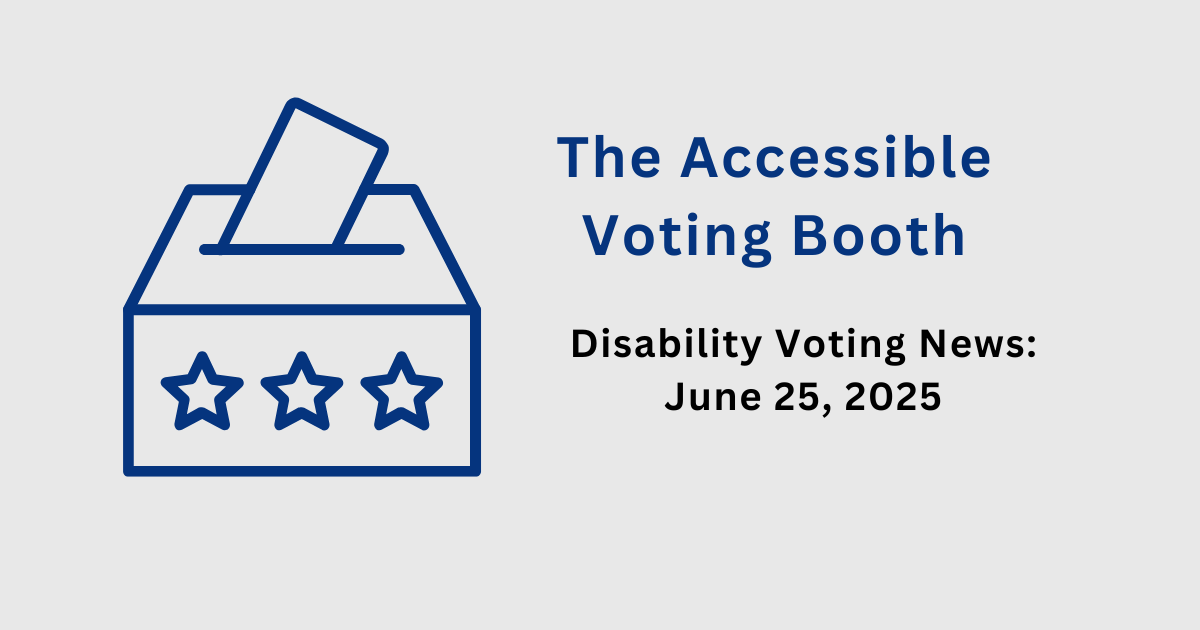
Welcome to The Accessible Voting Booth for June 25th, 2025. Like many around the country, I'm experiencing a record heat wave, and as I’m writing this introduction on Tuesday afternoon, I’m worried about the many voters in New York City who are headed to the polls for the primary in such severely hot weather. Luckily, Governor Hochul recently signed legislation to repeal a ban on handing out food and drink to voters waiting in line at the polls–a critically important move ahead of a heat wave bringing a heat index of 85 to 110 degrees. I’m also thinking of the many poll workers, canvassers, and election protection volunteers who mobilized despite the extreme heat and hope that they get lots of rest in a well-air-conditioned room today.
Today, we’re going to discuss election accessibility in Wisconsin, the enactment of new curbside voting and voting assistance restrictions in Texas, and how Trump’s Executive Order on voting impacts the U.S. Election Assistance Commission.
Wisconsin Elections Commission reports improvement in polling place accessibility in 2024 (via WisPolitics).
The Wisconsin Elections Commission (WEC) recently published a report on their polling place accessibility audits, sharing that polling place accessibility has improved from 2023.
The WEC is required to publish a report each odd-numbered year on voting barriers that people with disabilities and elderly voters face in casting their ballot, and for the 2024-2025 election season, they reviewed 477 polling places across 299 municipalities in accordance with the 2010 Americans with Disabilities Act Standards for Accessible Design. They reported that the average number of non-compliant findings per polling place was 5.2, down from 5.6 in 2023, and 12 polling places had a perfect score. While this does mean that only 12 out of 477 polling places were fully accessible according to their survey, there is a modest improvement from 2023.
These findings show the importance of monitoring and reporting on polling place accessibility. Many disabled voters can tell you that polling places have accessibility barriers, from inaccessible parking and entrances to problems with the accessible voting equipment, but quantitative data is critical evidence to show how prevalent these issues are. I’m pleased that Wisconsin requires the WEC to conduct these reviews–few states seem to require elections officials to regularly monitor and report on polling place accessibility.
In many states, Protection and Advocacy agencies conduct polling place accessibility surveys, but many of these P&As don’t have full access to the interior to the polling place (as state law may prevent that access). P&As may not have the resources and capacity to conduct thorough polling place accessibility surveys across a large number of polling places over several election cycles.
When states aren’t required to evaluate polling place accessibility, it puts the burden on the disability community to try to hold election officials accountable to following long-standing accessibility laws. Instead, more states should follow in Wisconsin’s footsteps and require election officials to monitor and improve polling place accessibility. Of course, this should be done in consultation with the disability community, as disabled voters have intimate knowledge of the barriers they experience in the voting process. By partnering with the disability community, elections officials can make progress towards meeting the promise of the Americans with Disabilities Act and ensure that every voter has equal access to private and independent voting.
Texas Gov. Abbott signs HB 521 into law, increasing restrictions on providing assistance to voters (via Voting Rights Lab).
In the May 14th issue of The Accessible Voting Booth, I covered Texas HB 521, a law that was deceptively promoted as “improving accessibility of voters with disabilities” but which actually increases restrictions around providing assistance to voters with disabilities. Here are its most concerning provisions:
- HB 521 would require curbside voters to sign an oath affirming their need to vote curbside, and specify that curbside voting is available in only very limited circumstances. Voters who knowingly fail to complete the oath would be committing a misdemeanor. This could discourage people who need to use curbside voting from using it because they don’t feel “disabled enough” to meet the requirements or are judged as not eligible for using curbside voting.
- HB 521 would change the requirements for persons who assist seven or more voters with transportation to the polls. They would be required to sign a form describing the nature of their assistance if they support seven voters with transportation across early voting and Election Day. Currently, assistors only have to sign a form if they are providing simultaneous transportation to seven or more voters. If they don’t sign the form, it’s a misdemeanor. Additionally, county clerks would be required to report these assistants to the Secretary of State.
- HB 521 would also modify rules for curbside voting. If there are at least four election officers at the polling place, at least two must assist a voter with curbside voting, and the election officer may not assist in marking the ballot except in case of a physical disability that renders the voter unable to write and see or an inability to read the language in which the ballot was written.
As I mentioned back in May, lack of access to transportation is a major barrier for millions of Americans, so many voters may benefit from access to transportation to the polls, especially as Texas requires voters to have a qualifying reason (such as disability or being out of town) to vote by mail. Making those who provide transportation sign a form and then be added to a list that is provided to the Secretary of State could have a chilling effect on people and organizations providing this assistance, especially because we don't know what the Secretary of State will do with this information. People providing rides to the polls aren't doing anything wrong--they're simply giving people access to voting.
Additionally, the rules around curbside voting will make it more challenging for voters with disabilities to use it, as they may feel like they don’t meet the requirements to utilize curbside voting or to get the help they need with casting their ballot.
Of course, I’m not surprised that Greg Abbott signed this into law. He is the peak example of why we can’t just look at politicians with disabilities as “disability representation” without considering their voting record and stances on disability rights and disability justice. HB 521 was signed into law on Friday, June 20th.
Voting Rights Lab analyzes the impact (and threat) of Trump’s Executive Order on the U.S. Election Assistance Commission (via Voting Rights Lab).
In this month’s edition of The Lever, the Voting Rights Lab discussed Trump’s attempt to shape U.S. election policy through a broad Executive Order, recent court cases challenging that Executive Order, and the impact and importance of a bipartisan U.S. Election Assistance Commission.
As they cover in the piece, the U.S. Election Assistance Commission, or EAC, was created by the Help America Vote Act of 2002. The EAC creates the Voluntary Voting System Guidelines, certifies voting equipment, and even distributes grants to states to update election infrastructure. The EAC does critical work to advance accessibility of polling places by providing election officials with best practices for voting accessibility, conducting and participating in research on accessibility (including partnering with Rutgers University professors Doug Kruse and Lisa Schur to analyze the voting experiences of people with disabilities), and recognizing jurisdictions that are advancing election accessibility with their Clearinghouse Awards.
Of course, the work that the EAC does to certify voting equipment and create voting system guidelines has a major impact on accessibility for voters with disabilities, particularly those who need to use accessible voting equipment. This includes the creation of the Voluntary Voting System Guidelines, which are requirements and specifications for the functionality, accessibility, and security of voting equipment. Voting equipment is tested against these guidelines to gain certification from the EAC to be used in elections (although, as the name shows, adhering to the VVSG is voluntary, except if state laws mandate it).
In the Lever, the Voting Rights Lab discusses how Trump’s Executive Order (which I analyzed back in the March 26th issue of The Accessible Voting Booth) directs the EAC to require documentary proof of citizenship for voters, withhold funding from states that accept absentee ballots after Election Day, and decertify voting machines around the country. Courts have ruled that the EO exceeds Trump’s presidential authority. However, the Voting Rights Lab explains that the EAC may take action to comply with the EO in the future:
“In response to these lawsuits, the EAC has so far stayed within the bounds of its authority. It has not implemented Trump’s directives or made sweeping changes to election policies.
“However, this may not be the case for long. On July 2, the EAC will hold a meeting to discuss potential revisions to existing voting guidance. This comes despite the fact that the executive order conflicts with federal law and the U.S. Constitution.”
I encourage you to read the full analysis over on the Voting Rights Lab’s website.
Thank you for reading this week’s edition of The Accessible Voting Booth! As always, if you’d like to support the newsletter and my work, here’s how:
- Subscribe to the Accessible Voting Booth newsletter.
- Share this newsletter with your network to spread the word about disability voting rights.
- Leave me a tip. Thank you for supporting my work!

